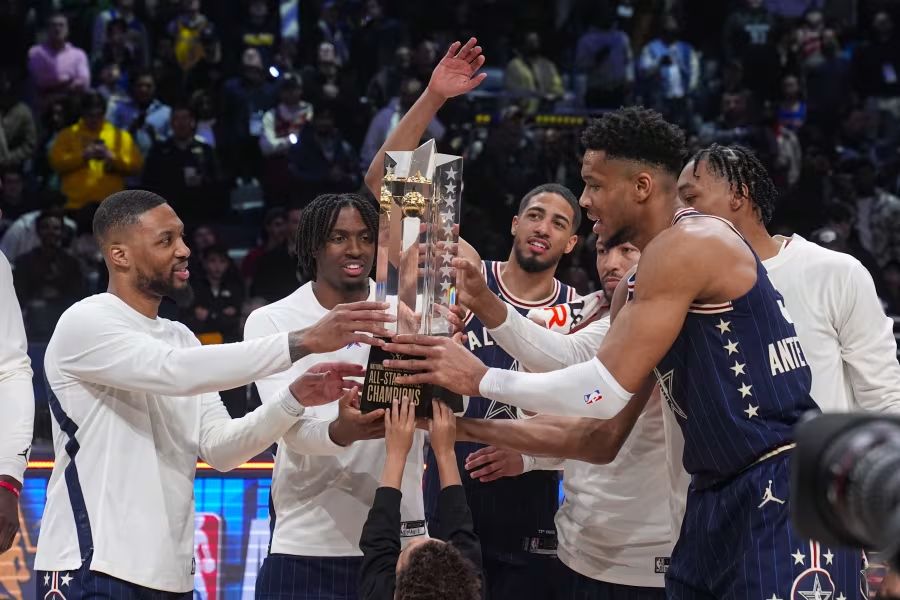The performing art of the All-Star Game in 2024 has been reduced to nothing but shooting.
Before the main game, the NBA officially called for players to take it seriously, emphasizing defense over pure entertainment. Yet on the court, the reality still diverged from public expectations. The Eastern Conference All-Stars scored 211 points, while the Western Conference had 186—together, 397 points, breaking the 2017 record of 374 by 23 points. The East’s 211 points alone set a new record, as did the 193 combined points in the first half.
Such a high score relied entirely on three-pointers. The two teams attempted 168 threes, making 67, with three-point scoring accounting for 50.6% of total points.
Traditionally, the All-Star Game should showcase four performing arts: playfulness, dunks, shooting, and buzzer-beaters.
- Playfulnesscreates contrast, adding depth to players’ personas.
- Dunkshighlight the NBA’s spectacle.
- Shootingaligns with modern trends.
- Buzzer-beatersemphasize competitive spirit.
Without even one, the game feels lacking. When only one remains—just shooting, as in this year’s game—it becomes tedious.
Since Shaquille O’Neal retired, fewer stars know how to have fun or are willing to. The All-Star Game still adheres to seniority, making it hard for young players to relax. At 22, Anthony Edwards talked about scoring only with his left hand, but on the court, he used his right. With LeBron James playing less than 14 minutes in the first half due to an ankle injury, there was no one to lead the playful energy.
Dunking has also lost its flair. A decade ago, Tracy McGrady often executed self-alley-oops, but no one does that now. Especially after Jaylen Brown faced 质疑 (criticism) in the Slam Dunk Contest the day before, other All-Stars hesitated to go for dunks.
If shooting and buzzer-beaters combined, the game could regain appeal, but excessive shooting kills the drama of a last-second win.
In the 2005 All-Star Game—LeBron’s first—the East and West attempted 46 threes total, with the East taking only 17. In 2024, Damian Lillard alone fired 23 threes. Even compared to 2023, when teams attempted 126 threes, 2024’s 168 was extreme.
Too many threes let the hot-hand team pull away easily, eliminating the need for a buzzer-beater.
Traditionally, the All-Star Game has three acts:
- First half: Players relax and have fun.
- Mid-third to mid-fourth quarter: Scores tighten.
- Final moments: Players compete fiercely, ideally ending with a buzzer-beater—like Curry’s 2022 heroics, where he rained threes and sealed the win.
In 2024, the script seemed to follow suit: The East led by 27, but the West cut it to 12 with 2:14 left in the third. Then Jaylen Brown, Barnes, and Trae Young drained back-to-back threes, extending the East’s lead to 24 by the quarter’s end.
Karl-Anthony Towns, the game’s leading scorer with 50 points, made only 4 of 13 threes, with the rest of his 38 points coming from inside. But the West answered with threes, making his efforts futile in closing the gap.
Without a buzzer-beater, the All-Star Game loses half its charm. Even perfect shooting can’t captivate fans like a clutch finish.
Lillard, 2024 All-Star MVP and defending Three-Point Contest champion, had a different performance. He made 11 of 23 threes in the game, but it lacked the thrill of the contest—where he essentially performed buzzer-beaters without defense.
In the regular season, a three-point-savvy team thrives because hitting shots under tight defense is impressive. In the All-Star Game, with minimal full-court pressure, stars shoot threes effortlessly, turning the game into a glorified practice.
A yearly spectacle turned forgettable—leaving a bitter taste.
We often recall the 2003 All-Star Game, Michael Jordan’s last. The drama started with voting: Should Jordan, not a starter, play in the starting lineup? Vince Carter yielded his spot before tip-off. The game itself was thrilling: Jordan’s fadeaway with 4.9 seconds left in the first OT gave the East a 2-point lead, but Kobe Bryant tied it with two free throws, sending it to a second OT.
It balanced competition, individual showmanship, and legacy. The All-Star Game is a show, and a show that tells a good story leaves a mark and grows the sport.
The key to a good story? Competition.
Before 2024, Shaq told host Tyrese Haliburton to chase points and the MVP, but Haliburton humbly said his strength was passing. Shaq, an old-school player, embodied the drive to compete—both externally and internally.
Haliburton didn’t compete. Despite 15 early points and high efficiency, he took only 15 shots, scoring 32—fourth in attempts and third in points for the East. The MVP went to Lillard, who took a team-high 26 shots for 39 points.
The 2024 All-Star Game had untold stories:
1.The first (and maybe last) LeBron-Durant-Curry trio: For the first time, they played on the same team, but their chemistry never materialized. LeBron’s one good pass to Curry felt like a beginning, but it was the end. If any misses the 2024 Paris Olympics, this trio may never reunite.
2.A generational torch-passing moment:
- Of 26 players (including injured Joel Embiid and Julius Randle), 7 were over 30, led by 39-year-old LeBron.
- Five Gen-Z stars: Haliburton, Maxey, Banchero, Barnes, Edwards with 2002-born Paolo Banchero 18 years younger than LeBron.
When Haliburton deferred, when Maxey, Banchero, Barnes, and Edwards took 27 shots total, and when 24-year-old Luka Dončić shot only 10 times, the generational shift vanished before it began.
Change hides in details. Years from now, will we look back on this All-Star Game and regret it was nothing but a shooting contest?
